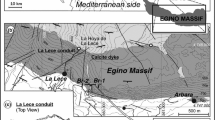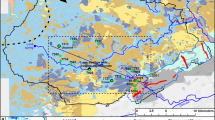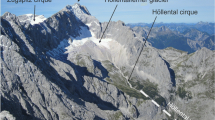Abstract
The Luxembourg Sandstone is the main strategic aquifer of the Grand-Duchy of Luxembourg, providing one third of the total drinking water resource in the country. In the unconfined part, the aquifer discharges through more than 400 springs, which are used for supply. The long-lasting diffuse contamination by pesticides (more recently Metolachor ESA) has been previously simulated assuming the aquifer as an equivalent porous medium, and using environmental tracers and baseflow characteristics. A statistical analysis of the whole data set of artificial tracer tests made for this aquifer (112 injections involving 102 springs) emphasized the role of the main fissures (NE–SW) for preferential groundwater flow and the importance of including them in a conceptual model involving a multiple-porosity aquifer. The results show that these fissures are influencing the whole flow system. The average peak velocity is 16 m/h and the average first arrival (maximum) velocity is 52 m/h (32 m/h for injection-well to spring traces alone), with a recorded maximum velocity of 350 m/h. The threats of infiltrating streams within catchments have also been characterized, suggesting the usefulness of tracer tests for optimizing protective measures. The main benefit of the study is the improvement in the ability to delineate safeguard zones accurately, according to more representative velocities and the strong anisotropy.
Résumé
Le grès du Luxembourg constitue l’aquifère principal et stratégique du Grand-Duché du Luxembourg, fournissant un tiers des ressources totales d’eau potable du pays. Dans sa partie libre, l’aquifère se décharge par plus de 400 sources, qui sont utilisées pour l’alimentation. La contamination diffuse durable par les pesticides (plus récemment par le Métolachlor ESA) a été simulée précédemment considérant l’aquifère en tant que milieu poreux équivalent, et en ayant recours à des traceurs environnementaux et aux caractéristiques du débit de base. Une analyse statistique de l’ensemble des données des essais de traçage artificiels réalisés au sein de cet aquifère (112 injections concernant 102 sources) a mis en évidence le rôle des principales fissures (NE–SW) sur l’écoulement préférentiel des eaux souterraines et l’importance de les introduire dans un modèle conceptuel concernant un aquifère à porosité multiple. Les résultats montrent que ces fissures influencent l’ensemble du système d’écoulement. La vitesse moyenne au pic est de 16 m/h et la vitesse moyenne de la première arrivée (maximum) est de 52 m/h (32 m/h du point d’injection aux seules traces à la source), avec une vitesse maximale enregistrée de 350 m/h. Les risques d’infiltration des cours d’eau au sein des bassins d’alimentation ont également été caractérisés, suggérant l’apport des essais de traçage pour optimiser les mesures de protection. Le principal avantage de l’étude est d'améliorer de la capacité de délimiter les zones de sauvegarde avec précision, en fonction des vitesses les plus représentatives et de la forte anisotropie.
Resumen
La arenisca de Luxemburgo es el principal acuífero estratégico del Grand-Duchy de Luxemburgo y proporciona un tercio del total de los recursos de agua potable del país. En la zona no confinada, el acuífero descarga a través de más de 400 manantiales, que se utilizan para el suministro. La contaminación difusa de larga data por plaguicidas (más recientemente Metolachor ESA) ha sido previamente simulada asumiendo el acuífero como un medio poroso equivalente, y utilizando trazadores ambientales y características del flujo de base. En un análisis estadístico de todo el conjunto de datos de los ensayos de trazadores artificiales realizados para este acuífero (112 inyecciones con 102 manantiales) se destacó el papel de las principales fisuras (NE–SW) para el flujo preferencial de aguas subterráneas y la importancia de incluirlas en un modelo conceptual que incluye un acuífero de múltiple porosidad. Los resultados muestran que esas fisuras están influyendo en todo el sistema de flujo. La velocidad máxima media es de 16 m/h y la velocidad media de primera llegada (máxima) es de 52 m/h (32 m/h sólo para los trazadores de pozo de inyección a manantial), con una velocidad máxima registrada de 350 m/h. También se han caracterizado las amenazas de infiltración de corrientes dentro de las cuencas, lo que sugiere la utilidad de las pruebas de los trazadores para optimizar las medidas de protección. El principal beneficio del estudio es la mejora de la capacidad de delimitar con precisión las zonas de protección, según velocidades más representativas y la fuerte anisotropía.
摘要
Luxembourg砂岩是Luxembourg大公国主要的战略含水层,提供了该国总饮用水资源的三分之一。在潜水含水层中,含水层有用于供水的超过400多个泉排泄出来。先前已经模拟了农药(Metolachor ESA)对持久扩散性污染,并假设含水层是等效的多孔介质,并使用了环境示踪剂和基流特征。对为此含水层进行的人工示踪试验的整个数据集(涉及102个泉的112次注入)的统计分析得出主要裂缝(NE–SW)对地下水优先流动的作用以及将其包括涉及的多孔含水层地下水概念模型中的重要性。结果表明,这些裂隙正影响整个流动系统。平均峰值速度为16 m/h,平均首次到达(最大)速度为52 m/h(从注入井至泉示踪的仅为32 m/h),记录的最大速度为350 m/h。还对流域入渗式溪流的威胁进行了表征,表明示踪试验对于优化防护措施的有用性。这项研究的主要优点在于根据更具代表性的速度和强各向异性来准确划定保护区的方法改进。
Resumo
O Arenito de Luxemburgo é o principal aquífero estratégico do Grão-Ducado de Luxemburgo, fornecendo um terço do total de água de beber do país. Na parte não confinada, o aquífero descarrega através de mais de 400 nascentes, que são utilizadas para abastecimento. A contaminação difusa de longa duração por pesticidas (mais recentemente Metolachor ESA) foi previamente simulada assumindo o aquífero como um meio poroso equivalente, utilizando-se também traçadores ambientais e características de fluxo de base. Uma análise estatística de todo o conjunto de dados de testes de traçadores artificiais feitos para este aquífero (112 injeções envolvendo 102 nascentes), enfatizou o papel das fissuras principais (NE–SO) para o fluxo preferencial de água subterrânea e a importância de incluí-las em um modelo conceitual envolvendo um aquífero de porosidade múltipla. Os resultados mostram que essas fissuras estão influenciando todo o sistema de fluxo. A velocidade de pico média é de 16 m/h, e a velocidade média da primeira chegada (máxima) é de 52 m/h (32 m/h do poço de injeção para os traços da nascente sozinhos), com uma velocidade máxima registrada de 350 m/h. As ameaças de infiltração em riachos em bacias hidrográficas também foram caracterizadas, sugerindo a utilidade de testes de traçadores para otimizar medidas de proteção. O principal benefício do estudo é a melhoria na capacidade de delinear zonas de salvaguarda com precisão, de acordo com velocidades mais representativas e com a forte anisotropia.















Similar content being viewed by others
References
Adamovič J, Mikuláš R, Navrátil T (2015) Spherical and ellipsoidal cavities in European sandstones: a product of sinking carbonate dissolution front. Zeitsch Geomorph 59(Suppl 1):123–149
AGE (2010) Leitfaden für die Ausweisung von Grundwasserschutzzonen [Guidelines for the designation of groundwater protection zones]. https://eau.public.lu/eaux_souterraines/zone_protection/leitfaden_schutzzonen.pdf. Accessed 29 May 2020
AGE (2015) Plan de gestion pour les parties des districts hydrographiques internationaux Rhin et Meuse situées sur territoire luxembourgeois (2015–2021) [Management plan for the international river basin districts Rhine and Meuse on Luxembourger territory 2015–2021]. Administration de la Gestion de l’Eau (AGE). http://geoportail.eau.etat.lu/pdf/plan%20de%20gestion/FR/2e%20plan%20de%20gestion%20pour%20le%20Luxembourg%20(2015–2021)_22.12.2015.pdf. Accessed 29 May 2020
AGE (2020) Désignation de zones de protection des eaux souterraines destinées à la consommation humaine [Designation of groundwater protection zones for drinking water]. Administration de la Gestion de l’Eau (AGE) https://eaupubliclu/publications/brochures/ba_ZP_eau_potable/ZP_eau_potable_frpdf. Accessed 29 May 2020
Auler AS, Meus P, Pessoa FP (2020) Water tracing experiments in low-pH quartzite karst water, Chapada Diamantina, northeastern Brazil. Advances in Karst Science, Eurokarst 2018, Springer, Cham, Switzerland, pp 183–191
Barker AP, Newton RJ, Bottrell SH, Tellam JH (1998) Processes affecting groundwater chemistry in a zone of saline intrusion into an urban sandstone aquifer. Appl Geochem 13(6):735–749
Bley J (2010) Hydrochemisch-mikrobiologische und markierungstechnisch gestützte Abgrenzung von Grundwässern im Leesbechtal (SW-Luxemburg) Aachen (Bachelorarbeit RWTH Aachen) [Hydrochemical-microbiological and tracer-technology-supported demarcation of groundwater in the Leesbechtal (SW-Luxemburg) Aachen]. BA Thesis RWTH Aachen University, Aachen, Germany
Borghi A, Renard P, Cornaton F (2016) Can one identify karst conduits networks geometry and properties from hydraulic and tracer test data? Adv Water Resour 90:99–115
Colbach R (2005) Overview of the geology of the Luxembourg sandstone(s). Ferrantia 44:155–160
Debbaut V Bouezmarni M (2014) Aquifères des formations du Jurassique et du Trias en Lorraine belge [Aquifers in Jurassic and Trias formations in the Belgian Lorraine]. In: Dassargues A, Walraevens K (eds) Watervoerende lagen und grondwater in Belgïe/Aquifères et Eaux souterraines en Belgique. Academia Press, Gent, Belgium, pp 203–214
Farlin J, Maloszewski P (2013) On the use of spring baseflow recession for a more accurate parametrization of aquifer transit time distribution functions. Hydrol Earth Syst Sci 17:1825–1831
Farlin J, Drouet L, Gallé T, Pittois D, Bayerle M, Braun C, Maloszewski P, Vandenborght J, Elsner M, Kies A (2013a) Delineating spring recharge areas in a fractured sandstone aquifer (Luxembourg) based on pesticide mass balance. Hydrogeol J 21:799–812
Farlin J, Gallé T, Bayerle M, Pittois D, Braun C, El Khabbaz H, Elsner M, Maloszewski (2013b) Predicting pesticide attenuation in a fractured aquifer using lumped-parameter models. Groundwater 51(2):276–285
Farlin J, Gallé T, Bayerle M, Pittois D, Köppchen S, Krause M, Hofmann D (2018) Breakthrough dynamics of S-Metolachlor metabolites in drinking water wells: transport pathways and time to trend reversal. J Contam Hydrol 213:62–72
Flynn R, Schnegg PA (2003) Induced recharge tracer test in Aare River using solute and particle tracers. Induced recharge report 2003, 15 pp. https://www.researchgate.net/publication/259442977_Induced_Recharge_Tracer_Test_in_Aare_River_Using_Solute_and_Particle_Tracers. Accessed 29 May 2020
Fox R, Hauwell J, Hick S (2008) Le tunnel Grouft au Luxembourg: avancement par la méthode traditionnelle et soutènement par application de béton projeté fibré [Tunnel Grouft in Luxembourg: progression by the traditional method and support by application of fiber-reinforced shotcrete]. Tunnels OuvragesSouterrains 208:271–276
Groupe Spéléologique Luxembourgeois (2009) Höhlen: Luxemburgs geheimnisvolle Unterwelt [Caves - Luxembourg’s secret underworld]. Schortgen, Luxembourg, 159 pp
Hötzl H, Reichert B, Schnatmeyer C (1993) Kombinierte Markierungsversuche im Einzugsgebiet der Eisch, Luxembourg. [Multi-tracing in the Eisch River basin, Luxembourg]. Final report, Angewandte Geologie Karlsruhe, Germany
Jozja N, Lepiller M, Mondain PH, Muet P (2009) Fiabilité de l’interprétation des traçages utilisant des traceurs fluorescents: importance de la composante analytique et proposition d’une grille d’évaluation [Reliability of the interpretation of tracer tests with fluorescent tracers: relevance of the analytical component and proposal of an evaluation grid]. Géologues 163:67–75
Jozja N, Mondain PH, Muet P (2011) Réflexion sur la fiabilité des traçages au regard des difficultés analytiques [Reflexion about the reliability of tracer tests considering analytical difficulties]. Actes du 9ème Colloque d’hydrogéologie en pays calcaire, H2KARST, Besançon, France, 1–3 Sept 2011, pp 249–252
Käss W (1998) Tracing technique in geohydrology. Balkema, Rotterdam, The Netherlands, 581 pp
Kausch B, Maquil R (2018) Landscapes and landforms of the Luxembourg sandstone, Grand-Duchy of Luxembourg. In: Demoulin A (ed) World geomorphological landscapes: landscapes and landforms of Belgium and Luxembourg. Springer, Cham, Switzerland, pp 43–62
König A (2010) Tracertests im Luxemburger Sandstein: Hilfsmittel zur Ausweisung von Trinkwasserschutzzonen? [Tracer tests in the Luxembourg Sandstone: tools to identify drinking water protection zones]. BSc Thesis, RWTH Aachen University, Aachen, Germany
Kůrková I, Bruthans J, Balák F, Slavík M, Schweigstillová J, Bruthansová J, Mikuš P, Vojtíšek J, Grundloch J (2019) Factors controlling evolution of karst conduits in sandy limestone and calcareous sandstone (Turnov area, Czech Republic). J Hydrol 574:1062–1073
Langert J (2011) Erkundung der Aquiferhydraulik des ostlichen Luxemburger Sandsteins im Inblick auf die Kartierung der Grundwasservulnerabilität im Zuge der Schutzzonenausweisung von Trinkwasserassungen [Exploration of the aquifer hydraulics of the eastern Luxembourg Sandstone in view of the mapping of the groundwater vulnerability in the frame of the designation of protection zones for drinking water wells]. MSc Thesis. RWTH Aachen University Germany, Aachen
Leibundgut C, Maloszewski P, Külls C (2009) Tracers in hydrology. Wiley-Blackwell, London, 415 pp
Maurice L, Barker JA, Atkinson TC, Williams AT, Smart PL (2011) A tracer methodology for identifying ambient flow in boreholes. Groundwater 49(2):227–238
Medici G, West LJ, Mountney NP (2018) Characterization of a fluvial aquifer at a range of depths and scales: the Triassic St Bees Sandstone Formation, Cumbria, UK. Hydrogeol J 26(2):565–591
Medici G, West LJ, Mountney NP, Welch M (2019) Permeability of rock discontinuities and faults in the Triassic Sherwood Sandstone Group (UK): insights for management of fluvio-aeolian aquifers worldwide. Hydrogeol J 27(8):2835–2855
Meus P, Schnegg PA, Frippiat C, Monfort J (2014) Promises and limitations in the use of sulfonates colourless tracers in hydrogeology. Geol Belg 17(1): 90–95
Mondain PH, Muet P (2008) Proposition d’une grille d’évaluation des résultats des traçages en milieu karstique au moyen de traceurs fluorescents [Proposal of an evaluation grid for the results of tracer tests with fluorescent tracers in karst medium]. CFH Colloque Hydrogéologie et Karst au travers des travaux de M. Lepiller, Orléans, France, 17 May 2018, pp 191–205
Novakowski KS, Lapcevic PA, Voralek J, Bickerton G (1995) Preliminary interpretation of tracer experiments conducted in a discrete rock fracture under conditions of natural flow. Geophys Res Lett 22(11):1417–1420
Prevoo R (2007) Grundwassermarkierungsversuch im Einzugsgebiet der Quellfassungen in Wiersch (SW-Luxemburg). [Groundwater tracer experiment in the catchment area of the springs in Wiersch (SW-Luxembourg)]. Diploma Thesis RWTH Aachen University. Aachen, Germany, 94 pp
Sivelle V, Labat D (2019) Short-term variations in tracer-test responses in a highly karstified watershed. Hydrogeol J 27:2061–2075
Smart CC (1988) Artificial tracer techniques for the determination of conduit aquifers. Ground Water 26(4):445–453
Tellam JH, Barker RD (2006) Towards prediction of saturated-zone pollutant movement in groundwaters in fractured permeable-matrix aquifers: the case of the UK Permo-Triassic sandstones. Geol Soc Lond Spec Publ 263(1):1–48
Van den Bril K, Grégoire C, Swennen R, Lambot S (2007) Ground-penetrating radar as a tool to detect rock heterogeneities (channels, cemented layers and fractures) in the Luxembourg sandstone formation (Grand-Duchy of Luxembourg). Sedimentology 54:949–967
Von Hoyer M (1971) Hydrogeologische und Hydrochemische Untersuchungen im Luxemburger Sandstein [Hydrogeological and hydrochemical studies in Luxembourg Sandstone]. Publ Serv Géol Lux 21, 61 pp
Wagner JF, Schnatmeyer C, Wittlich M (1999) Hydrogeologische Detailuntersuchungen einzelner Trinkwasserquellen des Syndicat des Eaux du Sud (Koerich, Luxembourg) [Hydrogeological detailed investigations of some drinking water springs of the Syndicat des Eaux du Sud]. Report, Syndicat des Eaux du Sud, Koerich, Luxembourg
Willems L, Lenoir F, Levecq JM, Vicat JP (1993) Evolution du relief au Niger occidental: rôle de la fracturation du socle précambrien et de la formation de pseudo-karsts au sein de la lithomarge et de la couverture sédimentaire [Influence of the fracturation in the Precambrian basement and of dissolution phenomena in the lithomargin on the geomorphological evolution in West Niger]. C R Acad Sci Paris Sér II 147:97–102
Willems L, Pouclet A, Vicat JP (2002a) Existence de karsts en roches cristallines silicatées non carbonatées en Afrique sahélienne et équatoriale, implications hydrogéologiques [Existence of karsts into silicated non-carbonated crystalline rocks in Sahelian and equatorial Africa, hydrogeological implications]. Bull Soc Géol France 173(4):337–345
Willems L, Compère P, Hatert F, Boulvain F, Vicat JP, Pouclet A, Ek C (2002b) Karst in granitic rocks, South Cameroon: cave genesis and silica and taranakite speleothems. Terra Nova 14(5):355–362
Worthington SRH (2003) A comprehensive strategy for understanding flow in carbonate aquifer. Speleogen Evol Karst Aquifers 1(1):1–8
Worthington SRH (2015) Diagnostic tests for conceptualizing transport in bedrock aquifers. J Hydrol 529(2015):365–372
Worthington SRH, Soley RWN (2017) identifying turbulent flow in carbonate aquifers. J Hydrol 552:70–80
Worthington SRH, Smart CC (2016) Determination of tracer mass for effective groundwater tracer tests. Carbon Evapor 31:349–356
Worthington SRH, Smart CC, Ruland WW (2002) Assessment of groundwater velocities tot the municipal wells at Walkerton. In: Ground and water: theory to practice. Proceedings of the 55th Canadian geotechnical and 3rd joint IAH-CNC and CGS groundwater specialty conferences. Niagara Falls, ON, October 20–23, 2002, pp 1081–1086
Worthington SRH, Jeannin PY, Alexander EC, Davies GJ, Schindel GM (2017) Contrasting definitions for the term ‘karst aquifer’. Hydrogeol J 25:1237–1240
Wray RAL, Sauro F (2017) An updated global review of solutional weathering processes and forms in quartz sandstones and quartzites. Earth-Sci Rev 171:520–557
Acknowledgements
The authors are grateful to AGE (Administration de la Gestion de l’Eau), SES (Syndicat des Eaux du Sud) and many municipalities in Luxembourg for having favored this research. Also, this research could not have been done without the collaboration of the following Luxembourg consultant companies: Schroeder & Associés, Geoconseils, Best, and Enviro Services International. Our thanks go to the editors, to Giacomo Medici and to another anonymous reviewer for improving the quality of the manuscript. Many thanks also to Malcolm Field, Camille Ek and Pierre-André Schnegg for kindly reviewing the manuscript.
Author information
Authors and Affiliations
Corresponding author
Additional information
Publisher’s note
Springer Nature remains neutral with regard to jurisdictional claims in published maps and institutional affiliations.
Published in the special issue “Five decades of advances in karst hydrogeology”
Supplementary Information
ESM 1
(PDF 104 kb)
Rights and permissions
About this article
Cite this article
Meus, P., Willems, L. Tracer tests to infer the drainage of the multiple porosity aquifer of Luxembourg Sandstone (Grand-Duchy of Luxembourg): implications for drinking water protection. Hydrogeol J 29, 461–480 (2021). https://doi.org/10.1007/s10040-020-02274-z
Received:
Accepted:
Published:
Issue Date:
DOI: https://doi.org/10.1007/s10040-020-02274-z




